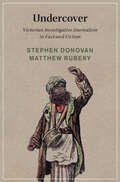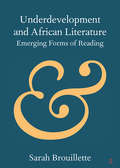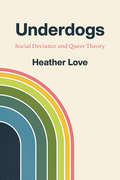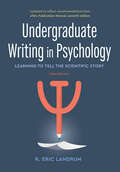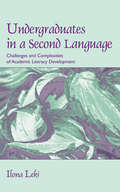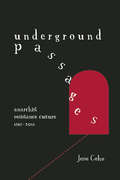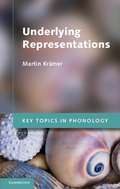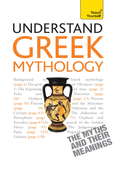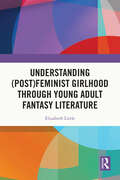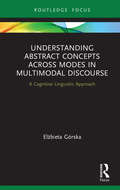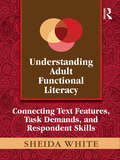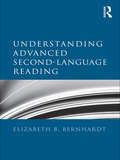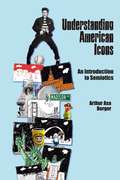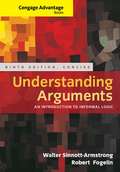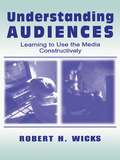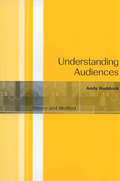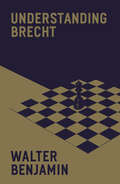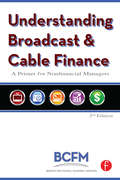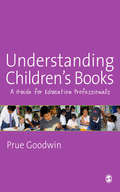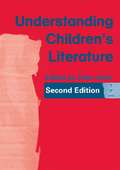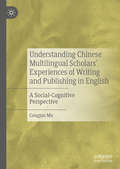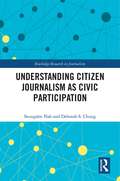- Table View
- List View
Undercover: Victorian Investigative Journalism in Fact and Fiction (Cambridge Studies in Nineteenth-Century Literature and Culture)
by Stephen Donovan Matthew RuberyThe scandalous 1866 publication of 'A Night in a Workhouse' altered the course of press history. Victorian journalist James Greenwood's disconcerting exposé of spending a night in a casual ward while disguised as a vagrant launched an enormously popular genre of newspaper writing that would come to be known as undercover reporting. Inspired by the exploits of the 'Amateur Casual', imitators infiltrated restricted areas by adopting disguises of their own as beggars, migrants, homeless people, mental patients, street performers, and single mothers. Undercover traces the seismic consequences that the radical innovation of 'going undercover' had for Victorian media, literature, and culture. This revisionist history of a distinctly British tradition of investigative journalism reconstitutes the pioneering investigations that shaped the global development of undercover reporting, analyses the format's vicarious appeal to audiences anxious about their own precarity, and traces the impact that incognito investigations had on the Victorian era's leading novelists.
Underdevelopment and African Literature: Emerging Forms of Reading (Elements in Publishing and Book Culture)
by Sarah BrouillettePeople looking for works in cities are immersed in English as the lingua franca of the mobile phone and the urban hustle – more effective instigations to reading than decades of work by traditional publishers and development agencies. The legal publishing industry campaigns to convince people to scorn pirates and plagiarists as a criminal underclass, and to instead purchase copyrighted, barcoded works that have the look of legitimacy about them. They work with development industry officials to 'foster literacy' – meaning to grow the legal book trade as a contributor to national economic health, and police what and how the newly literate read. But harried cash-strapped audiences will read what and how they can, often outside of formal economies, and are increasingly turning to mobile phone platforms that sell texts at a fraction of the price of legally printed books.
Underdogs: Social Deviance and Queer Theory
by Heather LoveA pathbreaking genealogy of queer theory that traces its roots to an unexpected source: sociological research on marginal communities in the era before Stonewall. The sociology of “social deviants” flourished in the United States at midcentury, studying the lives of outsiders such as homosexuals, Jews, disabled people, drug addicts, and political radicals. But in the following decades, many of these downcast figures would become the architects of new social movements, activists in revolt against institutions, the state, and social constraint. As queer theory gained prominence as a subfield of the humanities in the late 1980s, it seemed to inherit these radical, activist impulses—challenging not only gender and sexual norms, but also the nature of society itself. With Underdogs, Heather Love shows that queer theorists inherited as much from sociologists as they did from activists. Through theoretical and archival work, Love traces the connection between midcentury studies of deviance and the antinormative, antiessentialist field of queer theory. While sociologists saw deviance as an inevitable fact of social life, queer theorists embraced it as a rallying cry. A robust interdisciplinary history of the field, Underdogs stages a reencounter with the practices and communities that underwrite radical queer thought.
Underdogs: Social Deviance and Queer Theory
by Heather LoveA pathbreaking genealogy of queer theory that traces its roots to an unexpected source: sociological research on marginal communities in the era before Stonewall. The sociology of “social deviants” flourished in the United States at midcentury, studying the lives of outsiders such as homosexuals, Jews, disabled people, drug addicts, and political radicals. But in the following decades, many of these downcast figures would become the architects of new social movements, activists in revolt against institutions, the state, and social constraint. As queer theory gained prominence as a subfield of the humanities in the late 1980s, it seemed to inherit these radical, activist impulses—challenging not only gender and sexual norms, but also the nature of society itself. With Underdogs, Heather Love shows that queer theorists inherited as much from sociologists as they did from activists. Through theoretical and archival work, Love traces the connection between midcentury studies of deviance and the antinormative, antiessentialist field of queer theory. While sociologists saw deviance as an inevitable fact of social life, queer theorists embraced it as a rallying cry. A robust interdisciplinary history of the field, Underdogs stages a reencounter with the practices and communities that underwrite radical queer thought.
Underdogs: Social Deviance and Queer Theory
by Heather LoveA pathbreaking genealogy of queer theory that traces its roots to an unexpected source: sociological research on marginal communities in the era before Stonewall. The sociology of “social deviants” flourished in the United States at midcentury, studying the lives of outsiders such as homosexuals, Jews, disabled people, drug addicts, and political radicals. But in the following decades, many of these downcast figures would become the architects of new social movements, activists in revolt against institutions, the state, and social constraint. As queer theory gained prominence as a subfield of the humanities in the late 1980s, it seemed to inherit these radical, activist impulses—challenging not only gender and sexual norms, but also the nature of society itself. With Underdogs, Heather Love shows that queer theorists inherited as much from sociologists as they did from activists. Through theoretical and archival work, Love traces the connection between midcentury studies of deviance and the antinormative, antiessentialist field of queer theory. While sociologists saw deviance as an inevitable fact of social life, queer theorists embraced it as a rallying cry. A robust interdisciplinary history of the field, Underdogs stages a reencounter with the practices and communities that underwrite radical queer thought.
Undergraduate Writing in Psychology: Learning to Tell the Scientific Story
by R. Eric LandrumThis third edition features new writing samples, including a full-length literature review and full-length scientific research paper, and new guidance to reflect the seventh edition of the Publication Manual of the American Psychological Association. This accessible, practical guide to undergraduate writing takes the reader step by step through the process of developing research questions or theses, conducting literature searches, analyzing and synthesizing the literature, writing the paper, and more. Students will learn how to analyze and organize ideas for literature reviews, as well as how to prepare each section of a scientific research paper (introduction, method, results, discussion). This updated edition is full of: advice and resources, including a checklist and self-quiz; a sample grading rubric that an instructor might use; example reference formats; and several before-and-after writing samples showing marked-up changes. Bonus guidance is given for communicating effectively with instructors and preparing conference posters.
Undergraduates in a Second Language: Challenges and Complexities of Academic Literacy Development
by Ilona LekiThis is the first book-length study of bilingual, international, and immigrant students in English writing courses that attempts to fully embed their writing experiences within the broader frame of their personal histories, the human context of their development, and the disciplinary contexts of their majors. It addresses the questions: How useful are L2 writing courses for the students who are required to take them? What do the students carry with them from these courses to their other disciplinary courses across the curriculum? What happens to these students after they leave ESL, English, or writing classes? Drawing on data from a 5-year longitudinal study of four university students for whom English was not their strongest/primary language, it captures their literacy experiences throughout their undergraduate careers. The intensive case studies answer some questions and raise others about these students’ academic development as it entwined with their social experiences and identity formation and with the ideological context of studying at a US university in the 1990s.
Underground Passages
by Jesse CohnAn exhaustive study of the richly textured "resistance culture" anarchists create to sustain their ideals and identities amid everyday lives defined by capital and the state, a culture prefiguring a post-revolutionary world and allowing an escape from domination even while enmeshed in it. Whether discussing famous artists like Kenneth Rexroth, John Cage, and Diane DiPrima, or relatively unknown anarchist writers, Jesse Cohn clearly links aesthetic dynamics to political and economic ones. This is cultural criticism at its best.Jesse Cohn is the author of Anarchism and the Crisis of Representation: Hermeneutics, Aesthetics, Politics, and an associate professor of English at Purdue University North Central in Indiana.
Underlying Representations
by Martin KrämerAt the heart of generative phonology lies the assumption that the sounds of every language have abstract underlying representations, which undergo various changes in order to generate the 'surface' representations, that is, the sounds we actually pronounce. The existence, status and form of underlying representations have been hotly debated in phonological research since the introduction of the phoneme in the nineteenth century. This book provides a comprehensive overview of theories of the mental representation of the sounds of language. How does the mind store and process phonological representations? Krämer surveys the development of the concept of underlying representation over the last 100 years or so within the field of generative phonology. He considers phonological patterns, psycho-linguistic experiments, statistical generalisations over data corpora and phenomena such as hypercorrection. The book offers a new understanding of contrastive features and proposes a modification of the optimality-theoretic approach to the generation of underlying representations.
Understand Greek Mythology
by Steve Eddy Claire HamiltonAncient Greek myths shaped and were shaped by one of the most important culture in the history of the world. Even today, stories such as Oedipus, Narcissus, Odysseus and the Golden Fleece reverberate through our popular culture. This is the ideal introduction to Greek myth. The opening chapter is a detailed background to Greek culture and mythology. From then on , the book explores eleven well-known Greek myths, retelling them in modern English, and teasing out their meanings and cultural significance.
Understanding (Post)feminist Girlhood Through Young Adult Fantasy Literature
by Elizabeth LittleUnderstanding (Post)feminist Girlhood Through Young Adult Fantasy Literature takes advantage of growing critical interest in popular young adult texts and their influence on young people. The monograph offers an innovative approach by pairing traditional literary analysis with the responses of readers to show the complex ways that young people respond to the depiction of female protagonists. In the first section, the book utilises a feminist framework to examine young adult fantasy novels published from 2012 to 2018, with a particular focus on A Court of Thorns and Roses (Maas, 2015) and Red Queen (Aveyard, 2015). The analysis shows how strong female protagonists in young adult fantasy are postfeminist heroines who reinscribe patriarchal power structures, embrace limited understandings of gender roles, and persist in relationships that oppress them. In the second section, the monograph introduces empirical data from a series of focus groups discussing those same novels. The discussion shows that readers respond to these popular young adult fantasy texts with complexity and nuance that highlights their postfeminist subjectivities as they simultaneously reject and reinscribe elements of postfeminism in their understanding of the girl protagonists.
Understanding Abstract Concepts across Modes in Multimodal Discourse: A Cognitive Linguistic Approach (Routledge Focus on Linguistics)
by Elżbieta GórskaThis volume looks at spatialization of abstract concepts in verbo-pictorial aphorisms at work in the cartoons of a single artist. While extensive work has been done in studying spatialization of abstract concepts in grammar and lexicon within cognitive linguistics, this book is the first of its kind to provide a detailed account of such phenomena in multimodal discourse. The volume integrates a range of approaches from cognitive linguistics, including image schema theory, conceptual theory of metaphor, multimodal metaphor theory, the dynamic approach to metaphor, and a multimodal approach to metonymy, and applies this multi-faceted framework to a selection of cartoons from the work of Polish artist Janusz Kapusta. Taken together, these cartoons form the basis of two comprehensive case studies which explore the abstract concepts of "emotions" and "life," highlighting the ways in which cartoons can illustrate the important relationship between space, situated cognition, and language and in turn, a clear and systematic framework for establishing cohesive ties between the verbal and pictorial modes in multimodal cognitive linguistic research. The volume sheds new light on visual thinking and multimodal rendition of creative abstract thought.
Understanding Adult Functional Literacy: Connecting Text Features, Task Demands, and Respondent Skills
by Sheida White"This is a genuinely scholarly work ... It is based on [analysis of] the most up-to-date quantitative surveys that we have on adult literacy. These surveys are the gold standard in terms of documenting adult literacy in the United States ...The author analyzes these extensive surveys and puts them into a theoretical context in a way that has not been done before." – Rosemary J. Park, University of Minnesota "I don’t know of any book providing the same information. There is a shortage of literature in this area and the book is an excellent contribution." – Dolores Perin, Teachers College, Columbia University "The contribution of the theory is important – not only to adult literacy but to our understanding of the reading process at nearly every level ... Additionally, the application of multidimensional item response modeling to the new TTR theory offers a tantalizing view of how the predictive validity of a theory might be tested and used to provide practical results." – Larry Mikulecky, Indiana University Very often, individual differences in literacy performance are understood exclusively in terms of the characteristics of the reader. Drawing on a rich array of empirical research, the author presents a detailed and highly integrative new theory of functional literacy. The text-task-respondent (TTR) theory of functional literacy offers improved understanding of how successful performance on everyday literacy tasks involves a dynamic relationship among the text, the task, and the reader. This book will appeal primarily to assessment developers who wish to select tasks and texts of varying difficulty to yield more precise estimates of adult literacy; to researchers who study cognitive, linguistic, and discourse processes; and to teachers who want to find new ways to increase text comprehension among students, including English language learners and struggling readers. The text is appropriate for an advanced course in adult education, discourse analysis, educational measurement, educational psychology, literacy, or linguistics – or as a reference work for those interested in literacy.
Understanding Advanced Second-Language Reading
by Elizabeth B. BernhardtWhat distinguishes this book is its broad, yet thorough, view of theory, process, and research on adult second-language reading. Offering extensive discussions of upper-register second-language texts (both expository and narrative) that adult second-language readers encounter daily across the globe, it also presents an assessment schema for second-language text comprehension as well as for the assessment of teaching. Understanding Advanced Second-Language Reading: includes languages other than English in the discussion of second language reading is firmly anchored in a theory of second language reading ─ the concept of compensatory processing emphasizes the multi-dimensionality and dynamic nature of L2 reading development focuses on comprehension of upper-register literary texts balances theory and instructional practices. Filling the need for a coherent, theoretically consistent, and research-based portrait of how literate adolescents and adults comprehend, and learn to comprehend, at greater levels of sophistication and whether that ability can be enhanced by instruction, this is a must-have resource for reading and second-language researchers, students, and teachers.
Understanding American Icons: An Introduction to Semiotics
by Arthur Asa BergerThis brief, student-friendly introduction to the study of semiotics uses examples from 25 iconic locations in the United States. From Coney Island to Las Vegas, the World Trade Center to the Grand Canyon, Berger shows how semiotics offers a different lens in understanding locations taken for granted in American culture. He recasts Disneyland according to Freud, channels the Mall of America through Baudrilliard, and sees Mount Rushmore through the lens of Gramsci. A seasoned author of student texts, Berger offers an entertaining, non-threatening way to teach theory to undergraduates and that will fit ideally in classes on cultural studies, American studies, social theory, and tourism.
Understanding Arguments: An Introduction To Informal Logic
by Robert J. Fogelin Walter Sinnott-ArmstrongCENGAGE ADVANTAGE BOOKS: UNDERSTANDING ARGUMENTS, CONCISE EDITION, 1E uses everyday life experiences to teach the basics of informal logic. By taking out the non-essential instruction, this edition hones in on the "argument construction" involved in day-to-day life, and how to do it better. Plus, to round out the discussion, CENGAGE ADVANTAGE BOOKS: UNDERSTANDING ARGUMENTS, CONCISE EDITION, 1E includes a three-chapter overview of formal logic as well.
Understanding Audiences: Learning To Use the Media Constructively (Routledge Communication Series)
by Robert H. WicksUnderstanding Audiences helps readers to recognize the important role that media plays in their lives and suggests ways in which they may use media constructively. Author Robert H. Wicks considers the relationship between the producers and the receivers of media information, focusing on how messages shape perceptions of social reality. He analyzes how contemporary media--including newspapers, film, television, and the Internet--vie for the attention of the audience members, and evaluates the importance of message structure and content in attracting and maintaining the attention of audiences. Wicks also examines the principles associated with persuasive communication and the ways in which professional communicators frame messages to help audiences construct meaning about the world around them. Among other features, this text: * describes the processes associated with human information processing; * presents an analysis of the principles associated with social learning in children and adults and explores the possibility that media messages may cultivate ideas, attitudes, and criticisms of this perspective; * explains how most media messages are framed to highlight or accentuate specific perspectives of individuals or organizations--challenging the notion of objectivity in media information messages; * considers the effects of media exposure, such as whether the contemporary media environment may be partially responsible for the recent rash of school violence among young people; * analyzes the Internet as an interactive medium and considers whether it has the potential to contribute to social and civic disengagement as it substitutes for human interaction; and * evaluates the principles of the uses and gratifications approach as they apply to the new media environment, including traditional media as well as popular genres like talk shows and developing media systems such as the Internet. Intended for upper-level undergraduate and graduate students who need to understand the nature of the media and how they interact with these messages, Understanding Audiences promotes the development of media literacy skills and helps readers to understand the processes associated with engaging them in media messages. It also offers them tools to apply toward the shaping of media in a socially constructive way.
Understanding Audiences: Theory and Method
by Andy RuddockThe history of audience research tells us that the relationship between the media and viewers, readers and listeners is complex and requires multiple methods of analysis. In Understanding Audiences, Andy Ruddock introduces students to the range of quantitative and qualitative methods and invites his readers to consider the merits of both. Understanding Audiences: demonstrates how - practically - to investigate media power; places audience research - from early mass communication models to cultural studies approaches - in their historical and epistemological context; explores the relationship between theory and method; concludes with a consideration of the long-running debate on media effects; includes exercises which invite readers to engage with the practical difficulties of conducting social research.
Understanding Brecht
by Walter BenjaminA collection of essays of political philosophy by the renowned mid 20th-century critical theorist and literary criticThe relationship between philosopher-critic Walter Benjamin and playwright-poet Bertolt Brecht was both a lasting friendship and a powerful intellectual partnership. Having met in the late 1920s in Germany, Benjamin and Brecht, both independently minded Marxists with a deep understanding of and passionate commitment to the emancipatory potential of cultural practices, continued to discuss, argue and correspond on topics as varied as Fascism and the work of Franz Kafka. Faced by the onset of the &‘midnight of the century&’, with the Nazi subversion of the Weimar Republic in Germany and the Stalinist degeneration of the revolution in Russia, both men, in their own way, strove to keep alive the tradition of dialectical critique of the existing order and radical intervention in the world to transform it.In Understanding Brecht we find collected together Benjamin&’s most sensitive and probing writing on the dramatic and poetic work of his friend and tutor. Stimulated by Brecht&’s oeuvre and theorising his particular dramatic techniques—such as the famous &‘estrangement effect&’—Benjamin developed his own ideas about the role of art and the artist in crisis-ridden society.This volume contains Benjamin&’s introductions to Brecht&’s theory or epic theatre and close textual analyses of twelve poems by Brecht (printed in translation here) which exemplify Benjamin&’s insistence that literary form and content are indivisible. Elsewhere Benjamin discusses the plays The Mother, Terror and Misery of the Third Reich, and The Threepenny Opera, digressing for some general remarks on Marx and satire.Here we also find Benjamin&’s masterful essay &“The Author as Producer&” as well as an extract from his diaries that records the intense conversations held in the late 1930s in Denmark (Brecht&’s place of exile) between the two most important cultural theorists of this century. In these discussions, the two men talked of subjects as diverse as the work of Franz Kafka, the unfolding Soviet Trials, and the problems of literary work on the edge of international war.
Understanding Broadcast and Cable Finance: A Primer for the Non-Financial Manager
by Broadcast Cable Financial ManaFrom on-air talent contracts and FCC regulations to syndicated program amortization to music licensing fees, electronic media deal with financial principles and jargon that are unique to American business. Understanding Broadcast and Cable Finance helps explain all the financial complexities of a modern electronic media enterprise. Whether you are a news director, sales manager, engineer or any other non-accounting professional that has a stake in the success of your company, this book will bring you up-to-speed on the essentials of financial management for broadcasting and cable.
Understanding Child Language Acquisition (Understanding Language)
by Caroline RowlandTaking an accessible and cross-linguistic approach, Understanding Child Language Acquisition introduces readers to the most important research on child language acquisition over the last fifty years, as well as to some of the most influential theories in the field. Rather than just describing what children can do at different ages Rowland explains why these research findings are important and what they tell us about how children acquire language. Key features include: Cross-linguistic analysis of how language acquisition differs between languages A chapter on how multilingual children acquire several languages at once Exercises to test comprehension Chapters organised around key questions that summarise the critical issues posed by researchers in the field, with summaries at the end Further reading suggestions to broaden understanding of the subject With its particular focus on outlining key similarities and differences across languages and what this cross-linguistic variation means for our ideas about language acquisition, Understanding Child Language Acquisition forms a comprehensive introduction to the subject for students of linguistics, psychology and speech and language therapy. Students and instructors will benefit from the comprehensive companion website that includes a students’ section featuring interactive comprehension exercises, extension activities, chapter recaps and answers to the exercises within the book. Material for instructors includes sample essay questions, answers to the extension activities for students and a Powerpoint including all the figures from the book. www.routledge.com/cw/rowland
Understanding Children's Books: A Guide for Education Professionals
by Ms Prue GoodwinChildren's books play a vital role in education, and this book helps you to choose books that have the most to offer young children. Each chapter reflects on a different theme or genre and their role in educational settings, and recommends ten 'must reads' within each one. The themes covered include: - books for babies - literature for the very young - narrative fiction - books in translation - poetry - picture books - graphic texts. Early years professionals, childcare professionals and teachers working from nursery to Key Stage 3 will find this book a fascinating and useful resource.
Understanding Children's Literature: Key Essays From The International Companion Encyclopedia Of Children's Literature
by Peter HuntEdited by Peter Hunt, a leading figure in the field, this book introduces the study of children’s literature, addressing theoretical questions as well as the most relevant critical approaches to the discipline. The fourteen chapters draw on insights from academic disciplines ranging from cultural and literary studies to education and psychology, and include an essay on what writers for children think about their craft. The result is a fascinating array of perspectives on key topics in children’s literature as well as an introduction to such diverse concerns as literacy, ideology, stylistics, feminism, history, culture and bibliotherapy. An extensive general bibliography is complemented by lists of further reading for each chapter and a glossary defines critical and technical terms, making the book accessible for those coming to the field or to a particular approach for the first time. In this second edition there are four entirely new chapters; contributors have revisited and revised or rewritten seven of the chapters to reflect new thinking, while the remaining three are classic essays, widely acknowledged to be definitive. Understanding Children’s Literature will not only be an invaluable guide for students of literature or education, but it will also inform and enrich the practice of teachers and librarians.
Understanding Chinese Multilingual Scholars’ Experiences of Writing and Publishing in English: A Social-Cognitive Perspective
by Congjun MuThis book analyses the English writing and publishing experiences of 118 scholars from 18 Chinese universities from a social-cognitive perspective. It addresses the challenges and strategies multilingual scholars, particularly Chinese academics, reported in the process of writing and publishing in English. This allows the author to present a taxonomy of journal article writing strategies that correspond to the lived experiences of scholars in China, but which can also be applied to other contexts in the world. This book offers a step-by-step analysis of ethnographic case studies, insights and implications for teaching practice, as well as suggested directions for future research. It will be of particular interest to scholars in the fields of ERPP (English for Research Publication Purposes) as well as students and scholars of applied linguistics more broadly.
Understanding Citizen Journalism as Civic Participation (Routledge Research in Journalism)
by Seungahn Nah Deborah S. ChungUnderstanding Citizen Journalism as Civic Participation re-conceptualizes citizen journalism in the context of Habermas’s theory of the public sphere and communicative action, to examine how citizen journalism practice as civic participation may contribute to a heathier community and democracy in the civil society context. Citizen journalism has garnered growing attention owing to the participation of ordinary citizens in the performance of news production. Drawing on the authors’ decade-long collaboration on citizen journalism scholarship, this book posits a theoretical framework that relies on diverse communication perspectives to understand citizen journalism practice and its democratic consequences. This book will be of great relevance to scholars, researchers, professionals and policy makers working in the field of journalism and media studies, culture studies, and communication studies.
